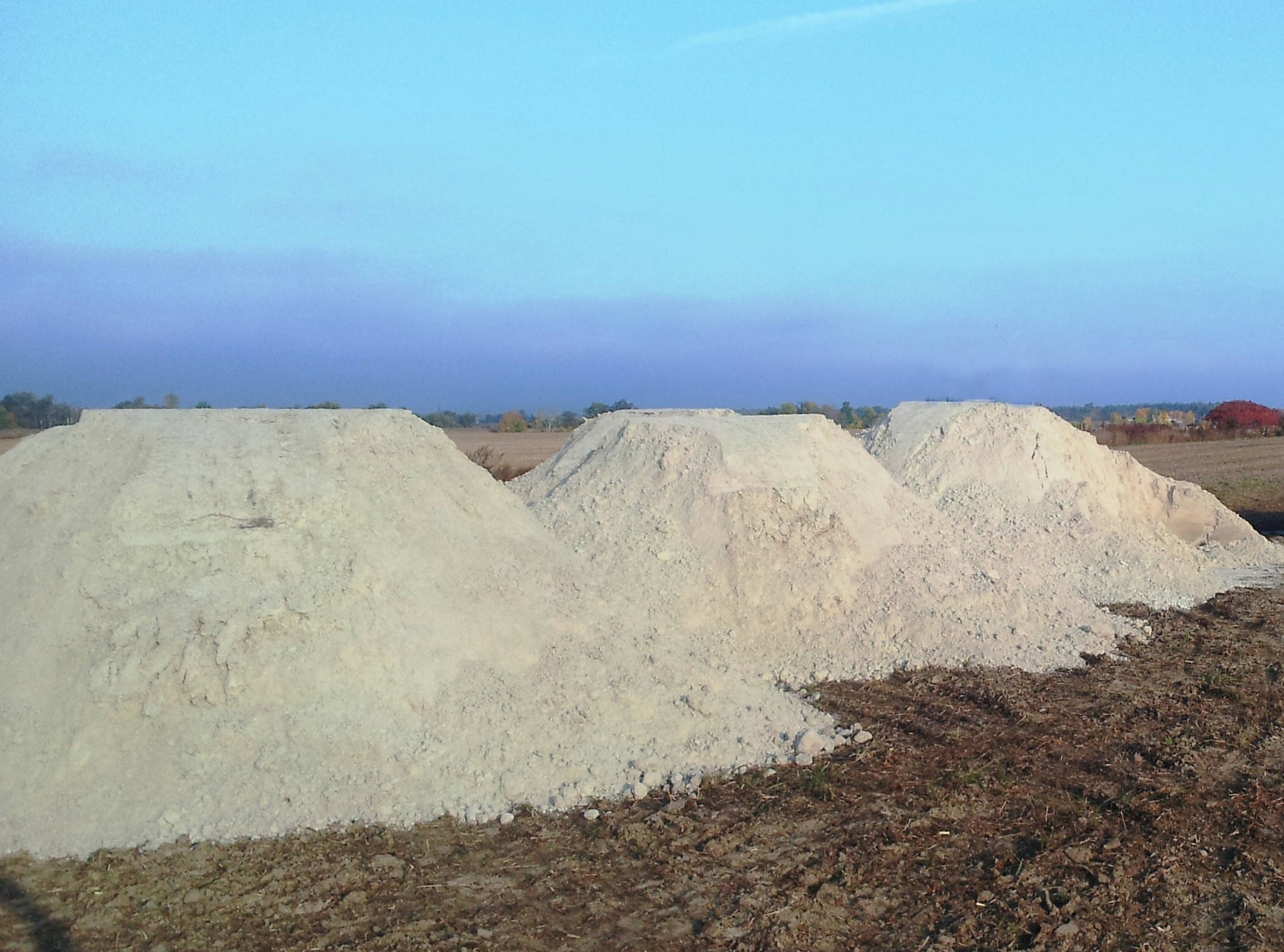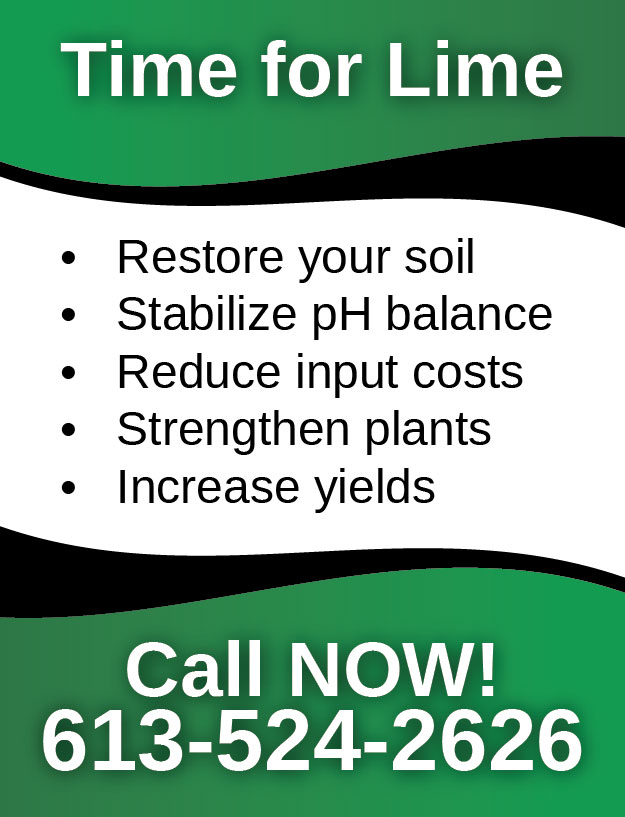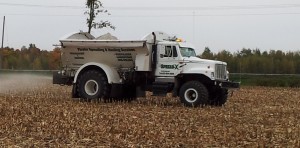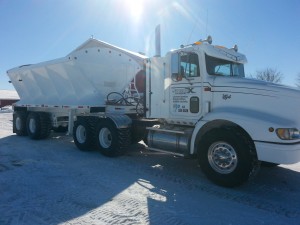Using Lime to Set Back Time
There are few things as effective as agricultural lime fertilizer when it comes to strengthening your soil. Used properly, it can help to restore your soil to the qualities it had in the past.
Agricultural Lime Fertilizer
When you use lime, you can dramatically reduce the amount of fertilizer required to get the yields you’re after. Agricultural lime helps to stabilize the pH balance of your soil. When you get those levels right, you simply don’t need as much chemical fertilizer so your input costs start falling right away.
Another benefit of lime is that it makes it easier for your plants to access the nutrients in the soil. The less effort they expend on accessing nutrients gives them more energy for growing strong and increasing their yield.
How Does Agricultural Lime Fertilizer Work?
The Agricultural Lime we provide is an all-natural mineral fertilizer. It reduces the acidity of your soil. Soils that are too acidic inhibit plant growth. Some plants simply won’t grow at all in soil that is too acidic. Agricultural Lime corrects soil acidity and pH levels by neutralizing the acids in soil, so that microorganisms can break down the organic material that replenishes the soil.
 Chemical sprays and fertilizers used to supply nutrients and for pest control contribute to soil acidity. Also, high efficiency crops (like corn and soybeans) and some genetically modified crops can remove high amounts of the soil’s nutrients, leaving it depleted and acidic.
Chemical sprays and fertilizers used to supply nutrients and for pest control contribute to soil acidity. Also, high efficiency crops (like corn and soybeans) and some genetically modified crops can remove high amounts of the soil’s nutrients, leaving it depleted and acidic.
Additives like calcium and magnesium, found in Agricultural Lime, are required to rebalance the soil’s structure. This also improves water penetration and facilitates the intake of major nutrients such as nitrogen, phosphorus and potassium.
How Often Does Limestone Need to be Applied?
This depends on the farming practice. For conventional farmers who use chemical fertilizers, sprays and grow high efficiency and GMO crops, the soil requires more frequent limestone application. On average every 2 to 3 years.
For organic growers, limestone can be spread less often, as organic farming processes result in a reduced build-up of acidity. Applications can be limited to every 5 to 10 years.
We work closely with you to find the right frequency based on the specific needs of your soil. And if you have questions — any time — we’re there for you.
How You Spread Limestone Matters
Just spreading more limestone isn’t enough. HOW you spread it makes a big difference.
In the same way that we want to reduce the impact on the soil when it comes to what we spread, we also want to make sure that the process of spreading it is just as thoughtful.
We’ve developed a unique spreading system that reduces the impact on your farm and your fields. We’ve reduced the amount of transportation required. In many cases we’ve eliminated the need to dump product on your farm before spreading altogether.
You see, most people will send a truck to your farm and dump a load of limestone. They get to it when they get to it. Then they bring in a front end loader and a spreader. They start loading and then distributing the lime. They use three vehicles, a lot of effort, more people, and more time. There’s a better way.
We’ve reduced the need for all of the disruptions that many farmers have faced in the past — maybe you’ve faced them too.
We have a single vehicle to do all of this. That’s right. A single vehicle.
We load it with limestone at our site and they drive straight to your farm where we’re able to drive straight to your fields and begin spreading immediately. It’s faster. It’s less disruptive. And it’s better for your farm.

Send us an email
“Like” Us
Frequently Asked Questions
What is Agricultural Lime?
Agricultural lime is a soil additive made from pulverized limestone. The primary active component is calcium carbonate. Additional chemicals vary depending on the mineral source and may include calcium oxide, magnesium oxide and magnesium carbonate.
All of our agricultural lime is naturally sourced.
Why is limestone used in agricultural soil?
Limestone is used to increase soil pH in acidic soil (the higher the pH the less acidic the soil). In other words, soil acidity is reduced and alkalinity increased.
In today’s farming practices, many chemical fertilizers and spraying techniques are used to supply the plant with more nutrients and to control pests. Unfortunately, this often contributes to increased soil acidity. Also, high efficiency crops like corn and soya that are GMO take up a lot of the soil mineral nutrients leaving the soil depleted and acidic. To rebalance the soil structure a good source of calcium and magnesium is required. This also improves water penetration and facilitates the intake of major plant nutrients such as nitrogen, phosphorus and potassium.
Other forms of lime have common applications in agriculture and gardening, including dolomitic lime and hydrated lime. Dolomitic lime may be used as a soil input to provide similar effects as agricultural lime, while supplying magnesium in addition to calcium.
In livestock farming, hydrated lime can be used as a disinfectant measure, producing a dry and alkaline environment in which bacteria do not readily multiply.
In horticultural farming it can be used as an insect repellent, without causing harm to the pest or plant.
How often does limestone need to be applied?
The frequency that limestone needs to be applied all depends on the farming practice. In the case of conventional agriculture that uses chemical fertilizers, spraying and GMO crops that contribute to soil acidity, the soil requires more frequent limestone application. On average every 2 to 3 years.
In the case of organic farming, limestone is spread less often due to good sustainable practices such as more crop rotation. Therefore an application every 5 to 10 years is typically sufficient.
What is the price of Limestone?
Before recommending a price for limestone, we always start with the soil analysis. It’s the key step before we start the process. Not all limestones are the same since they come from difference sources.
Determining the Agricultural Index (Ag Index) and Neutralizing Value (NV) is an essential part of choosing the right limestone for your soil. You can find these on the Limestone Analysis. In other words the Ag index determines the limestone efficiency and the Neutralizing value determines how fast the limestone will dissolve and be integrated into the soil. Therefore, higher the NV and AG INDEX, the higher the quality of the lime you get. Different grades, different price.
The other thing to look for is the pacing. This determines the size of the lime. The finer it is the better it is — it also affects the neutralizing value. These work together. – Please refer to our price list
Why do you have different types of lime?
We have different kinds of lime because they are effective at accomplishing different kinds of outcomes. For example:
- Calcitic Ag Lime is calcium based and is the one limestone that is used most commonly.
- Dolomitic Ag Lime is calcium and magnesium based and it is most often used for sandy loam soil.
- There are different grades of limes. The higher the grade of the limestone, the lower the application is required.
- With various quarry locations, we can better serve our clients by providing an efficient and fast service.
Where do you get your limestone?
We have a various sources of limestone. Our primary sources are:
- Graymont is North America largest supplier of lime and lime-based product.
- Tomlinson
- Bertrand quarry
Why is soil Analysis required and how is it conducted?
Spread-X provides soil analysis services separately and the cost is in addition to the purchase and distribution of the limestone itself (contact us for details and pricing.)
There are many things to look at when we receive your soil analysis before we make a recommendation.
- PH
- Buffer PH
- Saturation
- Ratio
- Crop planted
The soil pH is a measure of the acidity or alkalinity in soils. A pH below 7 is acidic and above 7 is alkaline. Soil pH is considered a master variable in soils as it controls many chemical processes that take place.
Soil testing is the most accurate tool available to determine nutrient requirements for a crop. It is actually made up of three discrete steps:
- Collecting a representative sample from the field
- Analyzing the sample using OMAFRA-accredited soil tests
- Relating the results of the soil analysis to nutrient requirements for optimum crop yields
We deal with a range of agronomists to assist us in this process. Most of our client base is referred to us by their agronomist who has already conducted a soil sampling, has the soil analysis, and has provided a recommendation that lime is required.
What is the moisture content in Lime?
This is the second most asked question about lime.
100% dry lime is borderline unspreadable. Its consistency is like fine flour, almost like soup. It is very hard to handle and extremely dusty and there is no such thing as a day without wind. Let’s face it, nobody wants to pay for limestone if the neighbour gets most of it.
The best moisture ratio that our 30 years of spreading has taught us is around 20% moisture. This ratio is so that no excess water is hauled and it spread very well in all conditions.
How do you determine your application rate?
The ratio is determined by the density of lime.
The spreading rate is recommended by the agronomist based on the soil analysis. The agronomist takes into consideration the rate of application of fertilizer, the crop that they are going to plant the following year, and other nutrient additives. Those are all factors that they take in to consideration when making a recommendation.
Is a GPS used for your application?
Yes we do use a GPS for our limestone application.
Actually, there are two ways to apply lime, the GPS way and the old fashion way, both practices are good.
The old fashion way has its benefits because it take into account the wind factor at different time of the day, so you need to offset your track for equal spreading at any time.
What type of vehicle is use to spread lime?
 This truck is multi-purpose, it can spread manure, compost, granulated natural fertilizer and limestone. When heading to the field, a trailer equipped with a backhoe is attached to the truck.
This truck is multi-purpose, it can spread manure, compost, granulated natural fertilizer and limestone. When heading to the field, a trailer equipped with a backhoe is attached to the truck.
The limestone is dumped onto the field by the transportation truck, the lime is then dumped into the flotation truck by the back hoe and we move forward with the spreading into the field.
The flotation name comes from the fact that the trucks large tires create less compaction of the soil in the field. The flotation truck can hold 18 MT per load.
The second truck in our fleet is the Direct Truck. This truck is specially built to go on both the road and directly into the field. It spreads lime, compost and granulated products.
 It’s still considered a flotation truck. The only difference is the size of the tires which, in general, are smaller. However, the Direct Truck has 10 tires in total which in return creates 14% less compaction for its weight.
It’s still considered a flotation truck. The only difference is the size of the tires which, in general, are smaller. However, the Direct Truck has 10 tires in total which in return creates 14% less compaction for its weight.
Clients really like the idea of the Direct truck because it is a faster and more efficient process.
There is no longer a need to dump lime in the field that can create some compaction with the loader and dump truck and, the added benefit is where the limestone is dumped, it is always a challenge to clean the site properly without taking out top soil and that part of land becomes Alkaline and as a result the crop doesn’t grow.
The total truck load, taking into account the density of the limes, it can hold up to 25 MT per load.
Where is the limestone stored?
We have a quarry located in St-Isidore off highway 417 at Exit 51 where we stockpile the limestone.
This is an ideal location for us to be able to deliver more quickly during the Spring seeding and fall crop harvest periods. The other advantage is that we ALWAYS have limestone available.
When is the best time to apply limestone?
The best time to apply limestone is Spring, Fall and summer!
The truth is that it all depends on the crop rotation and activities that you have underway in your fields.
The Ministry of Agriculture has establish guidelines that affect the spreading of limestone in the winter in order to avoid runoff.
How much Limestone is the norm required?
The maximum application is 4MT/acre in one single application. You can go up to 7-8MT/acre if a second application will be conducted in the season.
It’s recommended to wait the following year. The Ministry of Agriculture regulations state that the land is not apt to assimilate more than the recommended amount.
Why is Spread-X a leader in limestone spreading industry in Ontario and Quebec?
Spread-X has high standards when it comes to it serving its clients.
We use a series of efficient and innovative ways to respond to the high demand for service we receive in a short timeframe. We provide only quality, naturally-sourced products and we work closely with our clients.
We also have the product ready for our clients and all the machinery required to quickly serve our clients.
